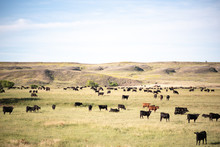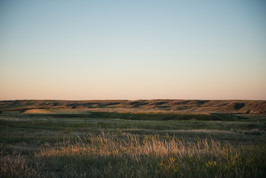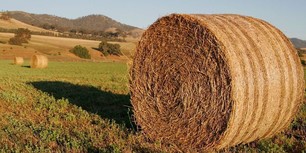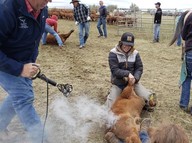
Grazing, technology team to reduce wildfire fuels
Study uses drones and scanners to determine impact of fall grazing on wildfire.
Tiffany Kozsan | Jun 14, 2021 Western-Farmer Stockman
widespread problem on Western rangelands is frequent and large wildfires, often due to cheatgrass. Doctoral student Tracy Shane, with the University of Nevada, Reno College of Agriculture, Biotechnology & Natural Resources, recently began a project using cutting-edge technology to see how sheep and cattle grazing might help control cheatgrass.
Cheatgrass is an invasive species from Eurasia that spreads quickly and is extremely flammable. It also creates its own safe space to grow – the more dead cheatgrass and additional plant material left on the ground, the more easily cheatgrass establishes over time.
Full Story
|
Farm Progress June 15, 2021
When faced with developing drought, ranchers often have questions. How severe is this drought? How long could it last? Is this as bad as the last drought we experienced, or is it the worst one? What are the chances it rains enough to produce normal forage over the coming weeks or months, and how much rain would be needed for a “normal” grazing year?
These are questions frequently asked by ranchers who have taken part in drought management workshops with the National Drought Mitigation Center and partner agencies, NDMC rural sociologist Tonya Haigh says.
Full article with links.

Montana Range Tour
September 8th & 9th, 2021 Malta
The Montana Range Tour September 8th & 9th will not disappoint. The Phillips Conservation District and partners have put together an amazing agenda, which includes E-Collars-Virtual grazing, dung beetles, drones, conservation projects, and keynote speaker, Dr. Dave Naugle. The 2021 Leopold Conservation Award Winner will also be announced the evening of the 8th. Cost is $70 for the 2 days and details can be found at 2021 Montana Range Tour.
|

Guidelines for preventing accidents while haying this summer
By Austin Grazier, Director, Montana Agriculture Safety Program
Operating large machinery has never been my strong suit. I am accident prone, the least bit mechanically inclined, and to be quite frank, not the greatest operator. My family in Townsend and my old bosses could attest (sorry Jim and Jess). So, I am writing this article for all the people like me who should take extra care when driving tractors; who need the constant reminder to slow down; the reminder to take off those dang spurs; and when in doubt, shove the tractor in neutral and hit the brakes.
Mid-June and early July marks the beginning of haying season on Montana’s farms and ranches. It is extremely busy, where 18-hour days are not uncommon, and hundreds of thousands of dollars’ worth of equipment is being used all over the ranch. In 2019, farms and ranches were the most fatal occupational location in Montana with the majority of those fatalities involving a tractor, pickup, or four-wheeler. This is the time of year we see an increase in machine related accidents and injuries, so share this article with everyone working on your farm or ranch.
Maintaining equipment is crucial for safe operation. Ensuring tractors, balers, rakes, swathers, and other equipment is in good condition can alleviate a lot of stress and lost time. By preventing breakdowns, you can ensure more time to operate safely and efficiently, versus rushing and trying to beat the rain (Lord willing we get some).
- Check and replace broken and worn parts
- Grease all moving components
- Shields and guards are there for your safety; replace broken ones and put them back on after removing
When operating haying equipment, it’s important to recognize the risks involved with haying. These include being run over, entanglement with the power take-off (PTO), and serious cuts or lacerations from sharp components. As owners or managers, be sure to train employees and family members how to operate equipment properly, discuss the hazards, and follow the safety tips below:
- Ensure PTOs and hydraulic equipment is stopped and isolated before working on or around the machinery.
- Keep clear and out of the path of running equipment.
- Maintain a proper setting and speed, and only travel at a speed that the equipment can handle.
- Never try to unplug a baler until the tractor is completely shut off and the PTO is disengaged.
- Be sure every tractor has a charged fire extinguisher and first aid kit.
- Always supervise inexperienced operators.
- If you get out of the tractor or machinery to fix something, take the keys with you to prevent someone starting the equipment when you’re under it.
Stacking and storing hay presents its own set of unique dangers. These include falling from elevation, being crushed by falling bales or suspended loads, and contact with machinery in operation. Reduce the chance of an accident occurring by following these safety guidelines:
- Keep foot traffic out of the loading/unloading/stacking zone.
- Keep stacks straight, if they begin to lean, unstack and start again.
- Use equipment that is large and powerful enough to handle the bales.
- When working on top of stacks, remain clear of edges and ensure a safe method to access the top of the stack.
- Never stand underneath a suspended load.
Minimizing risks, reducing costs, and increasing profits are staples in the agriculture industry. However, many do not realize that increasing safety is a key aspect in reducing costs and minimizing risks. By cultivating a culture of safety on your farm or ranch you can minimize lost time from injuries, reduce your liability, and most importantly keep yourself, your family, and your employees from being injured or killed. For more information visit www.mtagrisafety.com or contact Austin Grazier (406) 587-3153.
|

Working Lands Intern
This is the 2nd of four "in their own words" articles submitted by the class of 2021 interns.
Leah Fisher- June 2021
My name is Leah Fisher, I am a Working Lands intern and Rangeland Management student at Montana State University. I am looking forward to experiencing six different ranch operations across Montana this summer. This program has given me the opportunity to learn about the rancher’s perspective and management of the land, and to better understand what it takes to produce. This has been valuable to me as my goal is to become a range specialist for an agency. I believe that agriculture on public land is important, and I am interested in the ecological relationships between livestock and the landscape.
So far, I have helped with various ranch work from branding to haying and have been able to connect with employees of other land management organizations. One of my most memorable experiences so far has been gathering cattle using horses out of large pastures and finding straggling pairs hidden in hills and coulees, and then spending the day branding. This was one of my favorite moments as someone who has grown up around animals. It was a long, exciting day of wrestling calves, learning how to use nordforks, and I even had the opportunity to rope and drag out of the branding pen. I also really appreciated being able to see pasture in various stages of grazing and rest while out doing things like spraying weeds, fixing fence, and moving cattle. This was a helpful and led to learning about rotational grazing plans, and how grazing management varies depending on the ranch and the location throughout the state. I am eager to continue getting real-world experience with range monitoring, grazing management, plant identification, and more- all knowledge that I will take with into my future career.
|
Updates from the Northern Great Plains Conservation Delivery Network
-
New! Field Guide to Fish and Wildlife Conservation in the Farm Bill (2018-2023 Edition) (standard [nabci-us.org], full spread [nabci-us.org]). This is the latest iteration of a publication that has been produced for numerous previous Farm Bills. This is a must have document for anyone working with the Farm Bill Conservation programs or if you just want to learn about these important conservation programs.
- The Central Grassland Roadmap is seeking input from landowners and ranchers in the Great Plains to ensure their priorities and perspectives are included in our vision for the future of grasslands and the livelihoods they support. You may want to share this with your producer clients to capture their perspectives. You can assure them that the survey should take them less than 10 minutes, and if they are willing to share their email at the end of the survey, they’ll be entered into a randomized drawing for one of ten $100 gift cards. The survey must be completed by August 6th. Here’s the link to the survey: short survey [nam11.safelinks.protection.outlook.com].
Riparian Grazing Workshop
Lewis & Clark CD will be hosting a riparian grazing workshop Tuesday, September 14th in Augusta. Featuring guest speakers Dr. Clayton Marlow (MSU range professor) and Allen McNeal (McNeal Resources), we will discuss how grazing in stream areas can be a part of a rotation without damaging the stream system. Topics covered include stream form and function, grazing techniques that promote bank stabilization and flood resilience, and assistance programs.
Anyone with questions or looking to register for the event can contact me at connor@lewisandclarkcd.org (406.389.3886) or Chris Evans at chris@lewisandclarkcd.org
Current NRCS Grant Opportunities
Deadlines are currently approaching for proposals to three grant opportunities.
USDA Announces Grants for Urban Agriculture and Innovative Production [lnks.gd]
$4 million in competitive grants is available to support the development of urban agriculture and innovative production projects. USDA will accept applications on Grants.gov [grants.gov] for planning and implementation projects until midnight July 30, 2021.
USDA to Invest $15 Million in the Future of Conservation Through Innovation Grants Program [lnks.gd]
NRCS is investing up to $15 million to support the development of new tools, approaches, practices and technologies to further natural resource conservation on private lands through the Conservation Innovation Grants (CIG) program. CIG partners use creative problem solving and innovation to address our nation’s water quality, air quality, soil health and wildlife habitat challenges, all while improving agricultural operations. Proposals must be submitted through Grants.gov [grants.gov] by July 19, 2021.
USDA Announces Cooperative Agreements for Community Compost and Food Waste Reduction [lnks.gd]
$2 million in cooperative agreements is available for local governments to host Community Compost and Food Waste Reduction (CCFWR) pilot projects. The cooperative agreements support projects that develop and test strategies for planning and implementing municipal compost plans and food waste reduction plans and they are part of USDA’s broader efforts to support urban agriculture. USDA’s Office of Urban Agriculture and Innovative Production will accept applications on Grants.gov [grants.gov] until July 16, 2021.
July 2021
July 8, 2021 - July 8, 2021 Post Farm Field Day
July 10, 2021 - July 10, 2021 Rural Resilience Meetings - Reducing costs by increasing resilience in Malta, MT
July 12, 2021 - July 12, 2021 Rural Resilience Meetings - Reducing costs by increasing resilience - Glasgow, MT
July 13, 2021 - July 13, 2021 Central Agricultural Research Center Field Day
July 14, 2021 - July 14, 2021 Western Triangle Agricultural Research Center Field Day
July 14, 2021 - July 14, 2021 Rural Resilience Meetings - Reducing costs by increasing resilience in Circle, MT
July 15, 2021 - July 15, 2021 Northwestern Agricultural Research Center Field Day
July 16, 2021 - July 16, 2021 Urban Cooperative Agreements for Community Compost and Food Waste Reduction Proposals Due
July 18, 2021 - July 23, 2021 Montana Natural Resources Youth Camp
July 19, 2021 - July 19, 2021 National Conservation Innovation Grants Classic Proposals
July 20, 2021 - July 20, 2021 Eastern Agricultural Research Center Field Day
July 26, 2021 - July 28, 2021 76th SWCS International Annual Conference
July 29, 2021 - July 29, 2021 Western Agricultural Research Center Field Day
July 30, 2021 - July 30, 2021 Urban Agriculture and Innovative Production Grant Proposals Due
September 8th & 9th, Montana Range Tour- Malta
September 14th, Riparian Grazing Workshop- Helena
September 14-16, 2021 Soil Health Bus Tour 2021
September 15-17, Watershed Tour - Montana Watershed Coalition Council
Stacey Barta, State Coordinator for Rangelands
220 W. Lamme, Suite 1A
Bozeman, MT 59715
(406) 594-8481
SBarta@mt.gov
Rangeland Resources Committee:
Diane Ahlgren, Chair
John Hollenback, Vice Chair
Sigurd Jensen
Jim Anderson
Leah Lewis
Ron Devlin
|